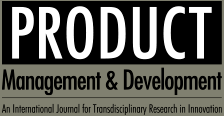Evaluating combined project management models: strategies for agile and plan-driven integration
Felipe Barreto Silva, Michael Jordan Bianchi, Daniel Capado Amaral
Abstract
The combination of agile and traditional practices is important for greater innovation in New Product Development (NPD). This paper analyzes ten combination proposals found in the literature, using the systematic bibliographical review method. Four of them did not show features associated with the combination. Four proposals recommend using agile project management associated with NPD process. Two proposals recommend using a general project plan, prepared through Work Breakdown Structure, scheduling, and integrated with agile iteration planning. The evaluation of these proposals indicated a shortage of recommendations and revealed two classes of combination strategies, namely bottom up and top down.
Keywords
References
AMARAL, D. C. et al. Gerenciamento ágil de projetos: aplicação em produtos inovadores. São Paulo: Saraiva, 2011.
AMBLER, S. W. Going beyond Scrum: disciplined agile delivery. Disciplined Agile Consortium, 2013. p. 1-16. (Disciplined Agile Consortium, White Paper Series).
ANITHA, P. C.; SAVIO, D.; MANI, V. S. Managing requirements volatility while “Scrumming” within the V-Model. In: INTERNATIONAL WORKSHOP ON EMPIRICAL REQUIREMENTS ENGINEERING (EMPIRE), 3., 2013, Rio de Janeiro. Proceedings... New York: IEEE, 2013. p. 17-23.
BARLOW, J. B. et al. Overview and guidance on agile development in large organizations. Communications of the Association for Information Systems, v. 29, n. 2, p. 25-44, 2011.
BATRA, D. et al. Balancing agile and structured development approaches to successfully manage large distributed software projects: a case study from the cruise line industry. Communications of the Association for Information Systems, v. 27, n. 21, p. 379-394, 2010. http://dx.doi.org/10.17705/1CAIS.02721.
BINDER, J.; AILLAUD, L.; SCHILLI, L. The project management cocktail model: an approach for balancing agile and ISO 21500. 27th IPMA World Congress. Procedia: Social and Behavioral Sciences, v. 119, p. 182-191, 2014. http://dx.doi.org/10.1016/j.sbspro.2014.03.022.
BOEHM, B. Get ready for agile methods, with care. IEEE Computer Society, v. 35, n. 1, p. 64-69, 2002. http://dx.doi.org/10.1109/2.976920.
BOEHM, B.; TURNER, R. Using risk to balance agile and plan-driven methods. Computer, v. 36, n. 6, p. 57-66, 2003. http://dx.doi.org/10.1109/MC.2003.1204376.
BOEHM, B.; TURNER, R. Balancing agility and discipline: a guide for the perplex. Boston: Pearson Education, 2004.
BOEHM, B.; TURNER, R. Management challenges to implementing agile processes in traditional development organizations. IEEE Computer Society, v. 22, n. 5, p. 30-39, 2005. http://dx.doi.org/10.1109/MS.2005.129.
CONFORTO, E. C.; AMARAL, D. C. Evaluating an agile method for planning and controlling innovative projects. Project Management Journal, v. 41, n. 2, p. 73-80, 2010. http://dx.doi.org/10.1002/pmj.20089.
CONFORTO, E. C.; AMARAL, D. C.; SILVA, S. L. Roteiro para revisão bibliográfica sistemática: aplicação no desenvolvimento de produtos e gerenciamento de projetos. In: CONGRESSO BRASILEIRO DE GESTÃO DE DESENVOLVIMENTO DE PRODUTOS, 8., 2011, Porto Alegre. Anais... Porto Alegre: UFRGS, 2011. Available from: <http://www.ufrgs.br/cbgdp2011/downloads/9149.pdf>. Access in: 29 July 2019.
CONFORTO, E. C.; REBENTISCH, E.; AMARAL, D. C. Project management agility global survey. Cambridge: Massachusetts Institute of Technology, Consortium for Engineering Program Excellence, 2014. Available from: <http://www.pmi.org/~/media/PDF/Surveys/PM-Agility-Global-Survey-PMI-Executive-Report-v10.ashx>. Access in: 29 July 2019.
COOPER, R. G. What’s next? After stage-gate. Research Technology Management, v. 57, n. 1, p. 20-31, 2014. http://dx.doi.org/10.5437/08956308X5606963.
COOPER, R. G. Agile-stage-gate hybrids. Research Technology Management, v. 59, n. 1, p. 21-29, 2016. http://dx.doi.org/10.1080/08956308.2016.1117317.
COOPER, R. G. Idea-to-launch gating systems: better, faster, and more agile idea-to-launch gating systems. Research Technology Management, v. 60, n. 1, p. 48-52, 2017. http://dx.doi.org/10.1080/08956308.2017.1255057.
EDER, S. et al. Differentiating traditional and agile project management approaches. Production, v. 25, n. 3, p. 482-497, 2014. http://dx.doi.org/10.1590/S0103-65132014005000021.
FERNANDEZ, D.; FERNANDEZ, J. Agile project management: agilism versus tradicional approaches. Journal of Computer Information Systems, v. 49, n. 2, p. 10, 2008.
GALAL-EDEEN, G. H.; RIAD, A. M.; SEYAM, M. S. Agility versus discipline: is reconciliation possible? In: INTERNATIONAL CONFERENCE ON COMPUTER ENGINEERING & SYSTEMS (ICCES), 2007, Cairo, Egypt. Proceedings… New York: IEEE, 2007. p. 331-337.
MAGDALENO, A. M.; WERNER, C. M. L.; ARAUJO, R. M. Reconciling software development models: a quasi-systematic review. Journal of Systems and Software, v. 85, n. 2, p. 351-369, 2012. http://dx.doi.org/10.1016/j.jss.2011.08.028.
NAWROCKI, J. et al. Balancing agility and discipline with XPrince. In: INTERNATIONAL WORKSHOP ON RAPID INTEGRATION OF SOFTWARE ENGINEERING TECHNIQUES, 2006, Geneva, Switzerland. Proceedings… Berlin: Springer, 2006. v. 3943, p. 266-277.
PROJECT MANAGEMENT INSTITUTE – PMI. PMI’S pulse of the profession. driving success in challenging times. Newtown Square, 2012. Available from: <http://www.pmi.org/~/media/PDF/Research/2012_Pulse_of_the_profession.ashx>. Access in: 29 July 2019.
RAHIMIAN, V.; RAMSIN, R. Designing an agile methodology for mobile software development: a hybrid method engineering approach. In: INTERNATIONAL CONFERENCE ON RESEARCH CHALLENGES IN INFORMATION SCIENCE (RCIS), 2., 2008, Marrakech. Proceedings... New York: IEEE, 2008. p. 337-342. http://dx.doi.org/10.1109/RCIS.2008.4632123.
SERRADOR, P.; PINTO, J. K. Does agile work? A quantitative analysis of agile project success. International Journal of Project Management, v. 33, n. 5, p. 1040-1051, 2015. http://dx.doi.org/10.1016/j.ijproman.2015.01.006.
SEYAM, M. S.; GALAL-EDEEN, G. H. Traditional versus agile: the tragile framework for information systems development. International Journal of Software Engineering, v. 4, n. 1, p. 63-93, 2011.
SHENHAR, A.; DVIR, D. Project management research: the challenge and opportunity. Project Management Journal, v. 38, n. 2, p. 93-99, 2007. http://dx.doi.org/10.1177/875697280703800210.
SOMMER, A. F. et al. Improved product development performance through agile/stage-gate hybrids: the next-generation stage-gate process? Research Technology Management, v. 58, n. 1, p. 34-45, 2015.
VINEKAR, V.; SLINKMAN, C. W.; NERUR, S. Can agile and traditional systems development approaches coexist? An ambidextrous view. Information Systems Management, v. 23, n. 3, p. 31-42, 2006. http://dx.doi.org/10.1201/1078.10580530/46108.23.3.20060601/93705.4.
WYSOCKI, R. K. (2007). Effective project management. 4th ed. Indianapolis: John Wiley & Sons.
ZAKI, K. M.; MOAWAD, R. A hybrid disciplined agile software process model. In: INTERNATIONAL CONFERENCE ON INFORMATICS AND SYSTEMS (INFOS), 7., 2010, Cairo, Egypt. Proceedings… Cairo: Cairo University, 2010. p. 1-8.

